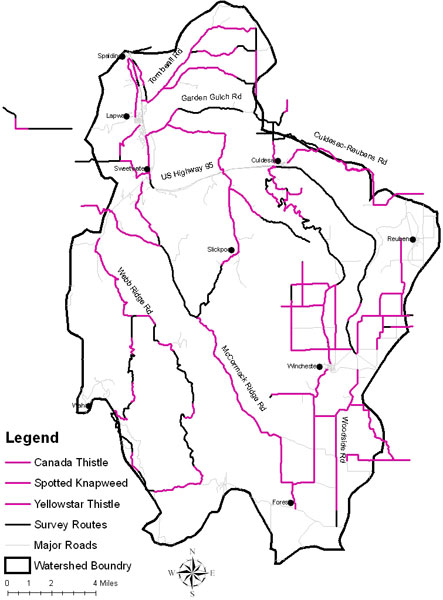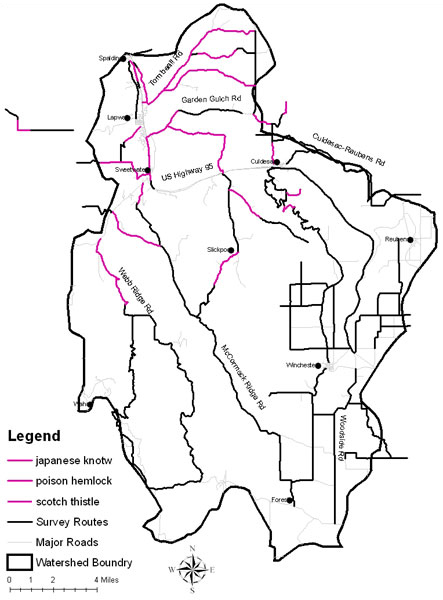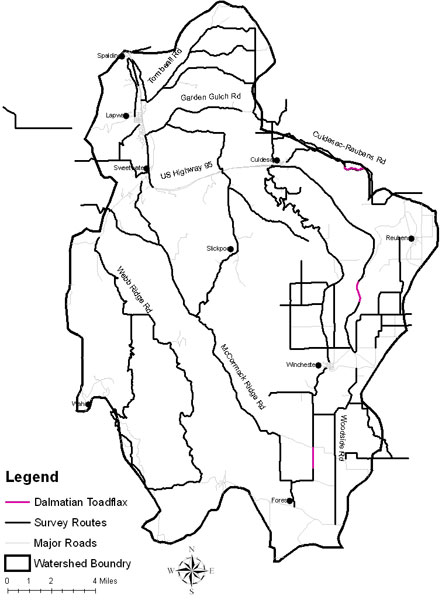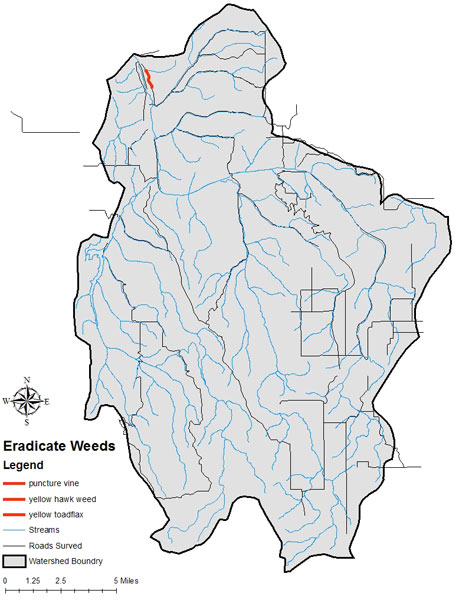In 2004, a total of 228.4 miles of road were surveyed in the Lapwai Creek watershed. The Lapwai Creek Roadside Weed Inventory Report provides details of the survey. Overall, 20 weed species were observed ranging from trace to 108.2 miles (Table 2). Canada thistle (Cirsium arvense) and St. John’s Wort (Hypericum perforatum) were the most widely distributed weeds observed, covering 108.2 and 104.6 linear miles, respectively. The distribution of other weeds will be discussed by group as defined by the CBWMA.
Table 2. List of Weed Species and Length of Infestation Present in the Lapwai Creek Watershed
| Weed Species | Management Group | Length |
| Canada Thistle | Reduce | 108.2 |
| Yellowstar Thistle | Reduce | 71.4 |
| Spotted Knapweed | Reduce | 17.3 |
| Total | 196.9 |
| Field Bindweed | Custodial | 59.7 |
| Sulfur Cinquefoil | Custodial | 35.9 |
| Total | 95.6 |
| Poison Hemlock | Contain | 44.0 |
| Scotch Thistle | Contain | 17.3 |
| Hybrid Knotweed | Contain | 1.0 |
| Jointed Goat Grass | Contain | Trace |
| Total | 62.3 |
| Dalmatian Toadflax | Control | 3.0 |
| Total | 3.0 |
| Puncture Vine | Eradicate | 1.0 |
| Yellow Hawkweed | Eradicate | Trace |
| Total | 1.0 |
| St. John’s Wort | Other Species | 104.6 |
| Hounds Tongue | Other Species | 12.4 |
| Common Burdock | Other Species | 6.8 |
| White Bryony | Other Species | 3.0 |
| Kochia | Other Species | 0.9 |
| Bull Thistle | Other Species | Trace |
| Common Tansy | Other Species | Trace |
| Total | 127.7 |

Reduce
Canada thistle, yellowstar thistle (Centaurea solstitialis), and spotted knapweed (Centaurea maculosa) were the three species classified in the reduce group. Overall the three were observed along 196.9 miles of road (Table 2.)

Custodial
Sulfur cinquefoil (Potentilla recta) and field bindweed (Convovusus arvensis) were the two species classified in the custodial group; they were observed along 95.6 miles of road (Table 2)

Contain
Poison hemlock (Conium Maculatum), scotch thistle (Onopordum acanthium), hybrid knotweed (Polygonum bohemicum), and jointed goat grass (Aegilops cylindrical) were the four species classified in the contain group. They were observed along 62.3 miles of road (Table 2)

Control
Dalmation toadflax (Lindaria dalmatica) was the only species observed in the control group. It was observed along 3.0 miles of road (Table 2).

Eradicate
Puncture vine (Tribulus terrestris) and yellow hawkweed (Hieracium pratense) were the two species classified in the eradicate group. Combined they were observed along 1.0 miles of road (Table 2).
Other species
St. Johns Wort, hounds tongue (Cynoglossum officinale), common burdock (Arctium minus), white bryony (Bryonia alba), kochia (Kochia scoparia), common tansy (Tanecetum vulgare), and bull thistle (Cirsium vulgare) combined were observed along 127.7 miles of road (Table 2). These introduced species are not addressed by the CBWMA, but were noted during the weed surveys.
Discussion/Recommendations
We recommend the eradication of all weed species distributed along less than 10 road miles throughout the entire watershed. Reducing their distribution along these roads may slow or prevent further distribution. Eradication methods might include chemical, mechanical, or biological means. Spotted Knapweed despite being distributed along more than ten miles of road, should also be included in this group. This is largely due to concerns about its invasive nature and extensive distribution in other areas nearby.
Due to limited resources and available methods of control, widely distributed weeds will be approached differently. For these species, we recommend efforts to slow, not eliminate, distribution. Treatments may include: treating the leading edge of infestations, eradication of small isolated infestations, or use of bio controls over the entire distribution. Species with extensive distributions should be treated by methods that treat at an appropriate scale, such as biological controls. These species include: Canada thistle, Yellowstar thistle, and St. Johns Wort.